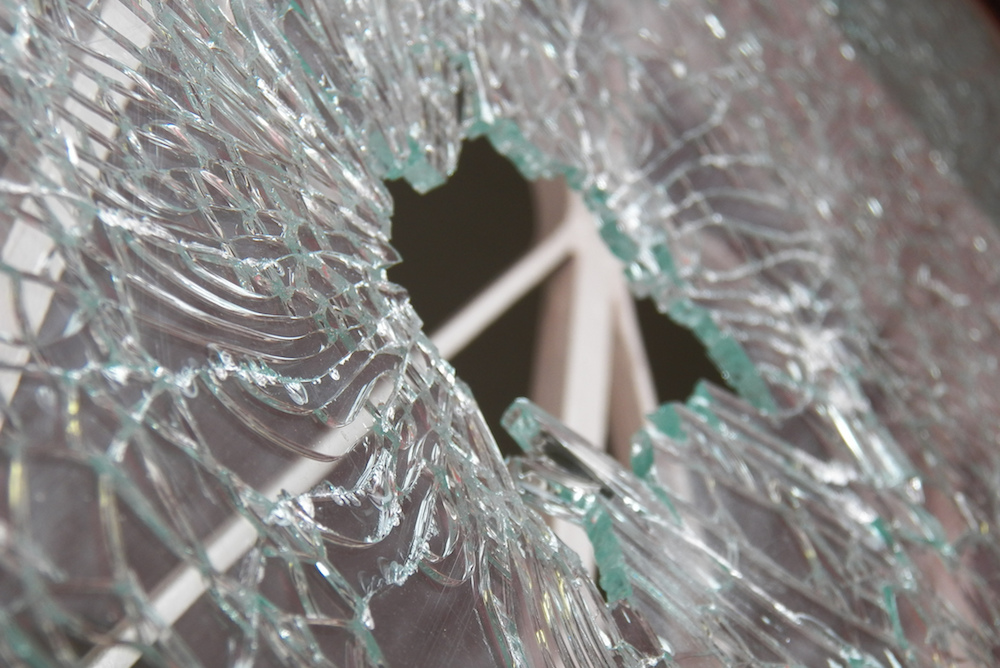
[Image above] Glass does more than just break—it can respond elastically, plastically, yield, or jam in response to strain. Researchers created a phase diagram demonstrating at which strains each deformation behavior occurs. Credit: Jakk Cutlip, Flickr
Quiz time: which is more elastic, glass or rubber?
If you answered “Insufficient information to decide,” you would be correct.
In common usage, people use the word “elasticity” to describe an object that can be stretched or deformed without breaking. By this definition, rubber is more elastic. However, physics defines elasticity as resistance to change, so glass would be more elastic using this rational.
Though these two definitions appear to contradict each other, both definitions rest on a core similarity: when an object is classified as elastic, that means it returns to its original shape or configuration once the deforming force is removed.
Just as defining elasticity may cause challenges for a layperson, calculating elasticity can be similarly challenging for scientists.
Unlike ordinary states of matter such as gases, liquids, and crystals, properties of glass strongly depend on the details of the preparation protocol. That means the equations of state (constitutive laws) of glass, which characterize their macroscopic properties, depend on preparation protocols, such as annealing history.
Researchers have looked at various ways glass responds to deformation, including elasticity, plasticity, yielding, and jamming. However, designing a model that unifies these phenomena is an important step toward holistically understanding glass deformation response.
And what better way to lay foundation for a model than by creating a phase diagram?
A phase diagram showing at which values of volume strains (strain changes object’s volume ) and shear strains (strain changes object’s shape) a glass exhibits each deformation behavior would be a perfect way to illustrate how glass deformation mechanisms relate to each other. And that’s exactly the phase diagram a team of researchers published in December.
Yuliang Jin, lead author and associate professor at Chinese Academy of Sciences, and his co-authors from Osaka University and CNRS used numerical simulations of hard spheres (a model glass former) to show how glass elasticity, plasticity, yielding, and jamming relate to how a glass is annealed—i.e., to the preparation protocol.
“The spheres don’t represent real molecules, but they do show whether such dense glasses are elastic,” says Hajime Yoshino, co-author and associate professor at Osaka University, in a press release. “We simulated how they responded to shear and normal [volume] strains. Our large supercomputers fully mapped out the strain phase-diagrams of glass formers for the first time, to explore their rheology.”
Each simulated glass showed four basic trends. Under small strains they were perfectly elastic, but at higher strains they became partially plastic, meaning they failed to recover their original state when strain was removed. As strain reached even higher levels, glass faced either of two opposite fates: total failure by fracturing (yielding) to release stress, or complete stop by jamming (viscosity increased and the material behaved as a solid).

Glass is stable between the jamming line (in blue) and the yielding line (in brown). The x-axis represents volume strain and the y-axis represents shear strain. Credit: Osaka University, Science Advances
On the phase diagram, the region between yielding (brown line above) and jamming (blue line above) defined where glass remained stable.
Importantly, the researchers did notice a difference between well-annealed and poorly-annealed glass when mapping the stable region for each.
“Our simulation results show that a well-annealed glass … yields abruptly—it is brittle,” say the researchers in the paper. “However, a poorly annealed glass … may instead continuously yield into a plastic flow state—it is more ductile.”
“We expect that near the melting point, even a well-annealed glass would behave similarly to a poorly annealed one, as it would become much ‘softer’ upon decompression,” they add.
In addition to the specific findings of how annealing relates to glass deformation response, Jin says the results also reveal an important general finding. “Our work is the first to demonstrate that ultimate fate of a glass under shear strain can be either yielding or jamming,” he says.
What do these results mean for glass modeling in the future? According to the researchers, an immediate application would mean modification of current mean field theory.
“The possibility of two yielding mechanisms is missed by the current [mean field] theory,” say the researchers in the paper. “A dynamical extension of MF might account for these effects.”
The open access paper, published in Science Advances, is “A stability-reversibility map unifies elasticity, plasticity, yielding, and jamming in hard sphere glasses” (DOI: 10.1126/sciadv.aat6387).
